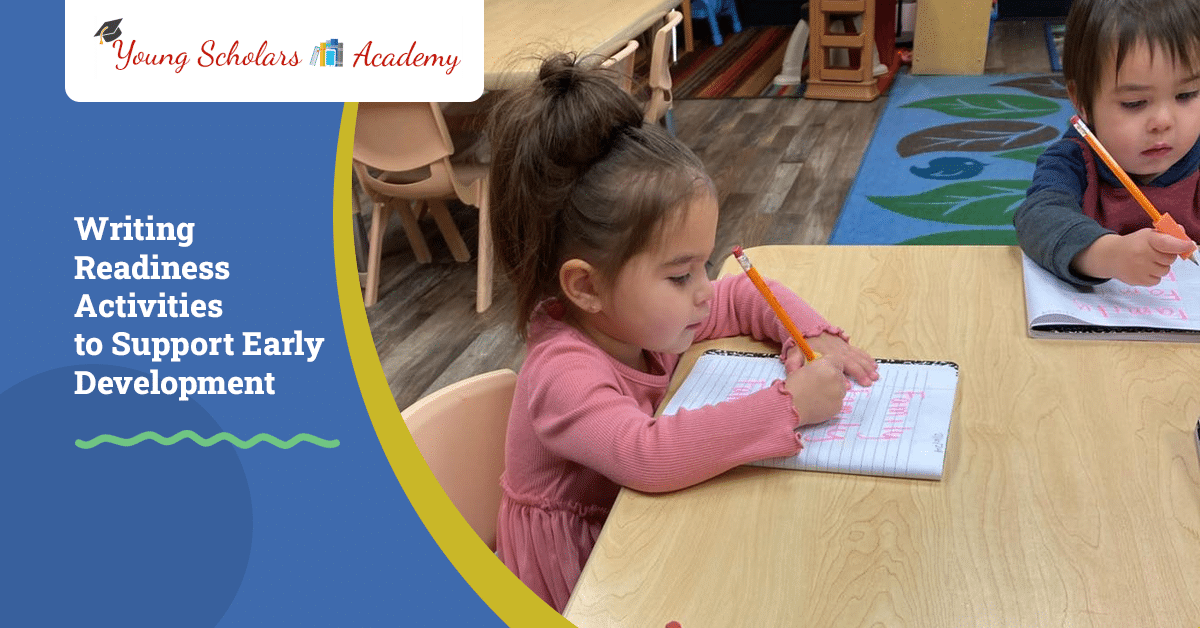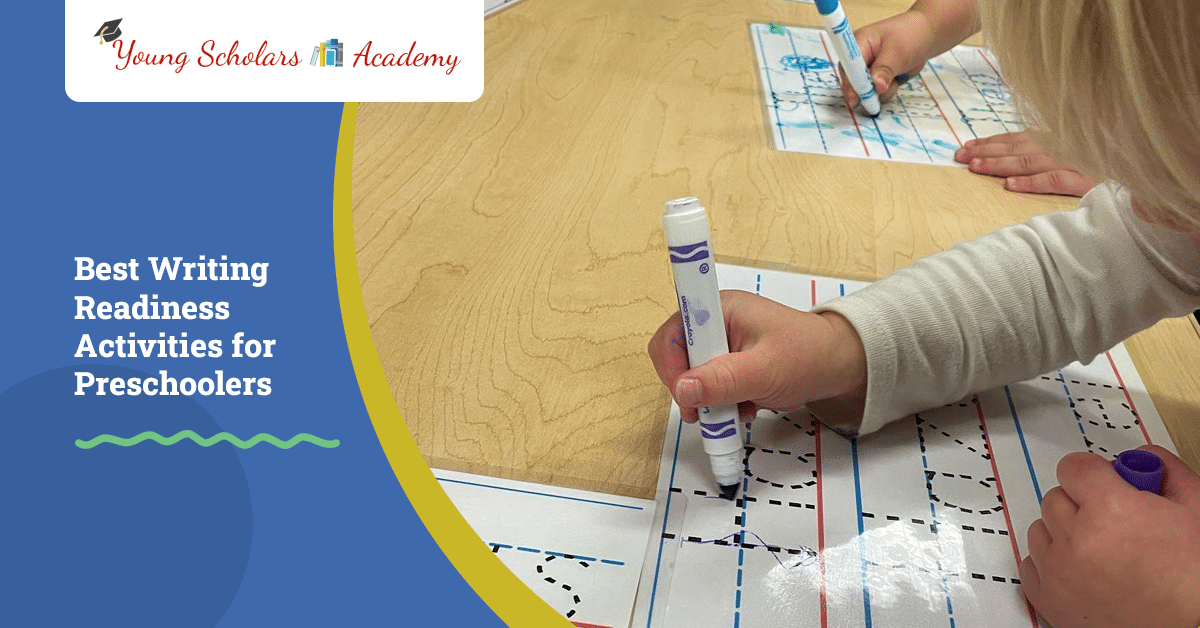Tracking writing development milestones is key to understanding your child’s growth from toddlerhood to pre-kindergarten. During these formative years, children transition from scribbling to more recognizable shapes, eventually forming letters and words.
We nurture this natural progression by providing a supportive environment where children can explore their creativity and build essential writing skills. With our child-centered approach, we help your little ones develop confidence and enthusiasm in their writing journey, ensuring they meet critical developmental milestones while enjoying the process.
Understanding the Stages of Writing Development and Ages
Writing development is a gradual process that begins long before children can form letters or words. It’s important to understand that these stages of writing development and ages vary depending on a child’s progress. We recognize every child’s unique journey, and our programs nurture writing skills in a way that feels natural and fun for toddlers and preschoolers alike.
Overview of Writing Development Stages
Writing development follows a predictable pattern, with children progressing from basic motor skills to more advanced tasks like forming letters and words. Early writing is often indistinguishable from drawing, as children use scribbles and marks to communicate. As they grow, these marks become more intentional, evolving into shapes, lines, and letters. Recognizing these stages helps parents and educators know when to support and encourage children through each step.
Milestones for Toddlers
For toddlers, the earliest writing stage involves exploring how to make marks on paper. At this stage, it’s less about the outcome and more about the experience of using their hands and fingers to control crayons, markers, or pencils. Some key writing development milestones for toddlers include:
- Holding crayons or markers with a fist grip
- Scribbling randomly across the page
- Experimenting with lines and circular shapes
- Imitating the act of writing, even if their marks are random
These early milestones are crucial in building the foundational skills needed for future writing. The focus here is on developing fine motor skills and hand-eye coordination, both essential for more advanced writing tasks later.
Milestones for Preschoolers
As children enter preschool, their writing skills become more refined. They start to gain better control over their hand movements, allowing them to form more recognizable shapes and even letters. Some common milestones for preschoolers include:
- Holding writing tools with a more mature tripod grip
- Drawing recognizable shapes like circles and squares
- Attempting to write letters, especially those in their name
- Beginning to recognize and copy simple letters
By the end of preschool, many children can write their names, though their letter formation may still be somewhat uneven or large. This stage is also when children understand that writing can communicate ideas and thoughts, not just be a fun activity.
Writing Readiness Activities to Support Early Development
Writing readiness is vital to a child’s early development, especially during the toddler and preschool years. During this time, children develop foundational skills that eventually lead to letter formation and writing fluency. By incorporating writing readiness activities into your child’s routine, you can set them up for routine; you can set them up for success while ensuring they enjoy the learning process.
Importance of Writing Readiness for Toddlers and Preschoolers
Writing readiness isn’t just about teaching children to hold a pencil or form letters—it’s about laying the groundwork for more complex skills like coordination, hand strength, and control. Toddlers and preschoolers are at a critical stage where they build fine motor skills and learn how to manipulate objects.
Writing readiness activities help them develop these abilities in a fun, pressure-free way. Engaging children in early writing activities fosters confidence and creativity. It also helps them develop patience, attention to detail, and accomplishment as they begin to see their progress.
Fine Motor Skill Development Through Fun Activities
Fine motor skills are the small movements children make with their hands, wrists, and fingers, all of which are crucial for writing. At Young Scholars Academy, we incorporate fun, hands-on activities that help strengthen these skills. You can do the same at home with some simple, engaging exercises:
- Playdough play: Squeezing, rolling, and molding playdough helps strengthen hand muscles.
- Beading and threading: Stringing beads onto a string encourages focus and fine motor coordination.
- Puzzles and blocks: These activities improve dexterity while allowing children to problem-solve.
These activities may not seem directly related to writing but build muscle strength and coordination for holding a pencil and forming letters later.
Encouraging Early Scribbling and Drawing at Home
One of the easiest ways to support writing readiness at home is by encouraging scribbling and drawing. Toddlers naturally love to explore with crayons, markers, and pencils, providing them with plenty of opportunities. Here are some ways to promote early writing skills:
- Create a scribble zone: Set up a space where your child can freely draw and write without worrying about making a mess.
- Offer different tools: Rotate between crayons, chalk, pencils, and markers to keep things exciting.
- Praise their work: Even if it’s just scribbling, showing appreciation for their efforts boosts their confidence and encourages them to continue.
By making these activities part of everyday play, children build the confidence they need to take the next step in their writing journey.
The Role of Parents in Fostering Early Writing Skills
Parents are crucial to fostering early writing skills by creating a positive and supportive environment. Children thrive when they feel encouraged and understood. As a parent, you can:
- Be a role model: Let your child see you writing, whether making lists, journaling, or writing notes.
- Create daily opportunities: Incorporate writing into daily routines—have your child “help” you by scribbling notes or drawing pictures.
- Celebrate progress: Acknowledge every little milestone, whether it’s a recognizable shape or their first attempt at writing a letter.
By actively participating in your child’s writing readiness, you help set the stage for a lifetime of learning and creativity. At Young Scholars Academy, we believe in empowering parents to be an essential part of their child’s educational journey, ensuring each child’s success from the start.
Best Writing Readiness Activities for Preschoolers
Preschoolers are at a pivotal stage in their writing development, where they transition from random scribbles to more intentional marks, including letters and shapes. By incorporating writing readiness activities into daily play, children can build the skills they need to develop strong writing habits. Here are some of the best hands-on activities to promote writing readiness for preschoolers.
Hands-On Activities to Promote Letter Recognition
Children begin recognizing letters at the preschool level and understand that they correspond to sounds and words. To help reinforce this connection, hands-on activities can make learning letters an enjoyable experience. Here are a few simple, engaging activities to promote letter recognition:
- Alphabet puzzles: Puzzles that feature letters encourage children to match shapes while recognizing each letter visually.
- Sensory writing trays: Fill a shallow tray with sand or rice, and let children use their fingers or a paintbrush to “write” letters. This activity combines tactile learning with letter practice.
- Letter scavenger hunts: Hide letters around the house or yard, and have your child find and identify each one. You can focus on their name or other meaningful words.
These activities make learning fun and help build familiarity with the shapes of letters, laying the foundation for future writing skills.
Tracing, Copying, and Building Fine Motor Skills
Once children recognize letters, the next step is learning how to form them. Tracing and copying activities are excellent for building fine motor skills and hand-eye coordination. Some practical ways to encourage this include:
- Letter tracing sheets: Provide preschoolers with large letters to trace, first with their fingers, then with crayons or pencils.
- Dot-to-dot letters: Connect the dots worksheets help children practice forming letters while having fun.
- Copying simple words: Encourage children to copy their name or other simple words from cards or books, gradually developing confidence in their writing ability.
These activities help children strengthen the small muscles in their hands, which are essential for more advanced writing.
Incorporating Writing into Everyday Play
Making writing part of everyday play helps preschoolers see it as a natural and enjoyable activity rather than a task. Some ways to do this include:
- Pretend play with writing elements: Incorporate writing into pretend scenarios, such as playing “restaurant,” where your child writes down orders, or playing “mail carrier” by writing and delivering letters.
- Drawing and labeling pictures: Ask your child to label their work after drawing pictures. Even if they aren’t forming letters perfectly yet, the process encourages the connection between writing and communication.
- Chalk and sidewalk writing: Use large surfaces like sidewalks or chalkboards for children to practice writing letters, offering a fun and dynamic way to practice.
Children develop writing skills without even realizing it by integrating writing into play!
Tools and Resources for At-Home Writing Practice
Creating a writing-friendly environment at home helps children practice their skills outside of school. Having the right tools and resources on hand can encourage regular practice. Here are some essentials:
- A variety of writing tools: Provide crayons, markers, pencils, and chalk to keep your child engaged in writing activities.
- Fun notebooks and writing surfaces: Special notebooks, easels, or dry-erase boards make writing more exciting and accessible.
- Apps and online resources: Plenty of educational apps offer interactive writing games and exercises designed for preschoolers.
At Young Scholars Academy, a child’s writing development should be a joyful experience. With the right activities and tools, parents can nurture their preschoolers’ writing skills naturally and excitingly, setting the stage for future success in school and beyond.
Conclusion
Tracking writing development milestones from toddler to pre-kindergarten is an exciting journey filled with growth, creativity, and achievement. By understanding the stages of writing development, engaging in fun writing readiness activities, and supporting your child’s progress at home, you can help them build strong writing skills that will serve them for years to come. At Young Scholars Academy, we are passionate about nurturing each child’s unique abilities and providing a supportive, enriching environment that fosters a love for learning.
Contact us today to learn more about how we can help your little one reach their full potential. Call us at (719) 522-9099 or visit us online at Young Scholars Academy. Let’s unlock your child’s creativity and set them up for success!


Leave a Reply